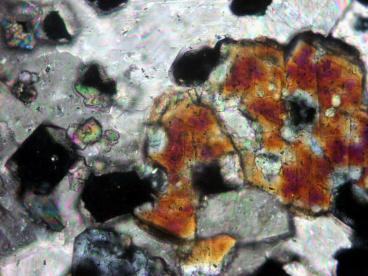Lecture notes on Metamorphic Petrology - PowerPoint PPT Presentation
1 / 11
Title:
Lecture notes on Metamorphic Petrology
Description:
tremolite + calcite = diopside + forsterite + H2O+CO2 Sheet-silicate impurity in calcite and dolomite marble adds variety by the following Al-bearing minerals to ... – PowerPoint PPT presentation
Number of Views:239
Avg rating:3.0/5.0
Title: Lecture notes on Metamorphic Petrology
1
(No Transcript)
2
(No Transcript)
3
(No Transcript)
4
(No Transcript)
5
1- Pure Carbonates (Limestone and dolomite)
A- Dolomite marble
- At HT/LP, dolomite marble loses CO2 to form
periclase (MgO) in condition lt900 C, and
consequently reacts with water to form brucite
(MgO(OH)2). Therefore, the common result of
decarbonation of dolomite or dolomitic marble is
a mixture of brucite and calcite. - Quartz bearing dolomitic marbles (calcite
dolomite quartz) develop a characteristic
sequence of Ca- and/or Mg-silicate as follows - (i) talc
- dolomite qurtz H2O talc calcite CO2
- (ii) tremolite in the greenschist facies,
- talc calcite quartz tremolite H2O CO2
(quartz rich) - talccalcite tremolite dolomite CO2 H2O
(quartz poor)
6
1- Pure Carbonates (Limestone and dolomite)
A- Dolomite marble, cont.
- (iii) diopside and/or forsterite in the
amphibolite facies - tremolitecalcitequartz diopsideH2O CO2
- tremolite dolomite forsterite calcite H2O
CO2 - And,
- (iv) diopside forsterite at higher grade.
- tremolite calcite diopside forsterite
H2OCO2 - Sheet-silicate impurity in calcite and dolomite
marble adds variety by the following Al-bearing
minerals to feature in the assemblage typically
they include zoisite, epidote and Ca-rich garnet
in the greenschist facies and anorthite in the
amphibolite facies.
7
Metamorphic zones developed in regionally
metamorphosed dolomitic rocks of the Lepontine
Alps
8
-2-Metamorphism of impure carbonates and marls
(Calc-silicates)
9
2- Calc-silicates
- Calc-silicates are rocks rich in Ca-Mg-silicate
minerals but poor in carbonate, - They form via the metamorphism of very impure
calcite or dolomite limestones, or from limy
mudstones (marls). - Since calcsilicates contain significant amounts
of other chemical components, such as Al, K and
Fe, minerals such as zoisite (epidote group),
garnet, Ca-plagioclase, K-feldspar, hornblende
and diopside could formed. A generalized zonal
sequence can be summarized as follows
10
I- Ankerite zone
- The lowest grade rocks
- It characterized by the assemblage ankerite
Ca(Mg,Fe)(CO3)2) quartz albite muscovite
chlorite
II- Biotite zone
- This zone is characterized by the coexistence of
biotite and chlorite without amphibole, via a
reaction such as - Ms Qtz ankerite H2O ? Cal Chl Bt CO2
- The upper part of this zone also characterize by
the replacement of albite by a more Ca-rich
plagioclase and a reduction in the amount of
muscovite present - Chl Cal Ms Qtz Ab ? Bt Pl H2O CO2
11
III- Amphibole zone
The appearance of Ca-amphibole is accompanied by
a further increase in the Ca content of the
plagioclase Chl Cal Qtz Pl ? Ca-amph
Ca-Pl H2O CO2
IV- Zoisite zone
Zoisite (Ca2(Al,Fe)3SiO4(OH)) often first
appears rimming plagioclase at contacts with
calcite grains, suggesting growth is due to the
reaction Ca-plagioclase calcite H2O ?
zoisite CO2
V- Diopside zone
At the highest grades diopside appears due to the
breakdown of amphibole Ca-amphibole calcite
quartz ? diopside H2O CO2































